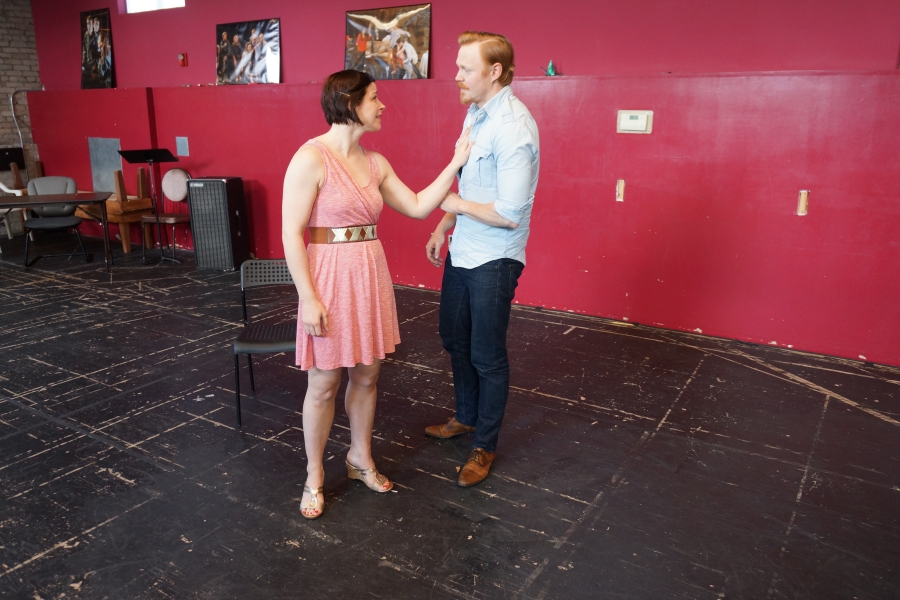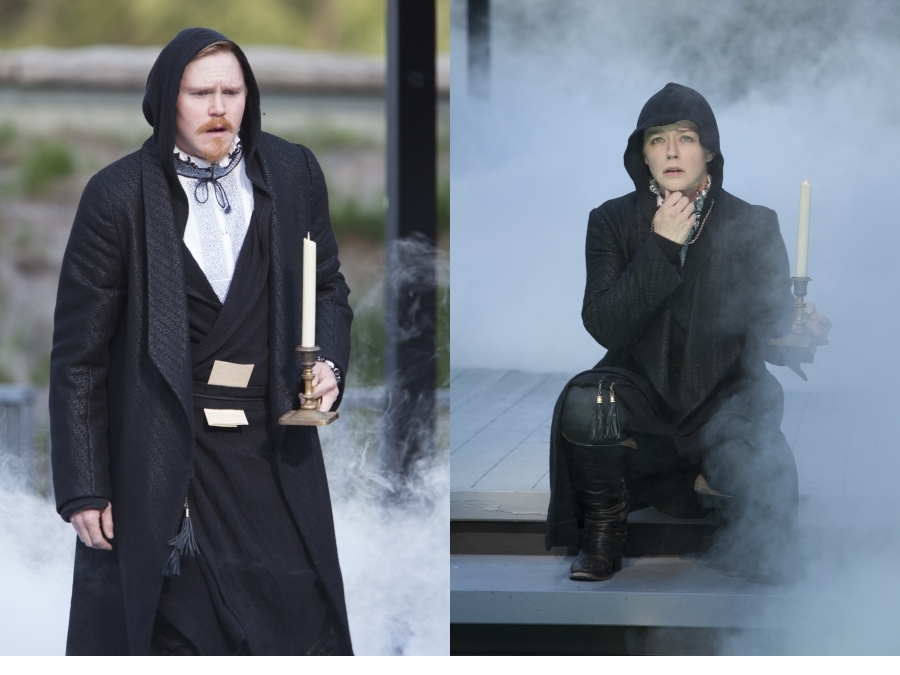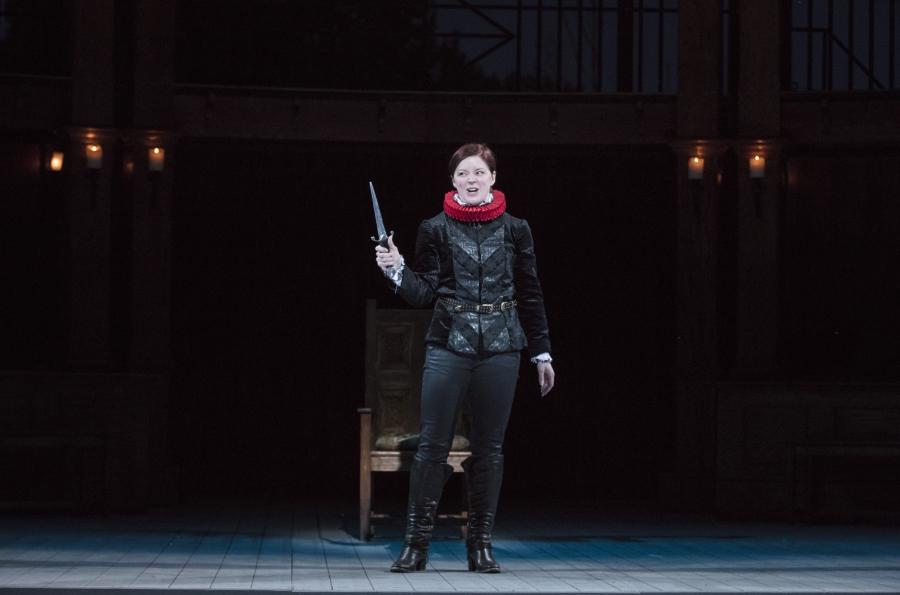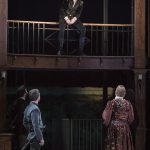On the day Hillary Clinton accepted the nomination of the Democratic Party to run for President, the phone rang at the home of Laura Welsh Berg, an Idaho Shakespeare Festival company actress. Director Charles Fee was on the line asking if she would audition to play the lead role in an upcoming ISF production of Hamlet.
“It was just, like, ‘The glass ceiling is tinkling around my ears!’” Berg said, recalling the unexpected offer.
One of William Shakespeare’s most complicated and ambitious characters, Hamlet famously navigates troubled relationships with his family and friends while being set upon by spies and machinations by his uncle, Claudius. Men are typically cast to play him, of course, but Berg was split-cast in the role, alongside fellow company actor Jonathan Dyrud, for runs of the play at ISF in June and at the Great Lakes Theater Festival in March and April.
Berg has played male characters at ISF Shakespeare productions before, and in playing Hamlet she joined a storied tradition of women taking up the role of the Danish Prince—a tradition that historically has held a mirror up to social and political tensions. Her run as the character was no different, highlighting a behind-the-scenes drama played out between artistry and women’s equity in theatre—a drama that drew its strength from the talents of director Fee, actress Berg, and actor Dyrud.
ISF has not shied away from casting women in roles written for men. Sue Galligan was cast as Peter Quince in A Midsummer Night’s Dream in the first play ever produced by the company, in 1977. A 2003 staging of Henry V embraced numerous sex-swapped characters. Berg herself played Fabian in the ISF production of Twelfth Night (2016) and Antonia in Much Ado About Nothing (2013).
In her 12 years at the company, however, Berg said she has rarely seen a traditionally male leading role go to a woman. Throughout its history, ISF has staged plays predominantly written by men that feature male leads, following entrenched theatrical traditions that still haven’t been shaken off. An Actors’ Equity study released in June 2017 showed that 39.1 percent of principal contracts for Off-Broadway plays went to women between 2013 and 2015. Meanwhile, the Count, a study conducted jointly between the Lilly Awards and the Dramatists Guild, offered a measure of professional possibilities for women in theatre: Across three seasons from 2011 to 2015, encompassing 2,508 productions, 22 percent of the productions had been written by women.
Casting women in male roles has been one of the ways ISF has circumvented a culture in which theatre programming overwhelmingly favors male playwrights, directors, and actors. In an email, ISF managing director Mark Hofflund wrote that such casting decisions “may be part of the company’s theatrical DNA and long-term perspective on its approach to art and life.”

Berg met the offer to try for Hamlet with skepticism: If she auditioned, she might be cast instead as Hamlet’s mother Gertrude or his spurned lover Ophelia, “and that would be that.” But she chose to see Fee’s offer as a way to open the door for herself and other women for important roles in the future.
“My dream was that if I give him a good enough audition, in a year, or three years, or five years—when he does finally cast a woman as Hamlet or Brutus or any of those male leads—I will feel like I was a part of it,” Berg noted. “I wanted to feel like I went in and showed him that women can do this.”
While Berg was busy managing her expectations about the part, Fee’s plans for this Hamlet were taking shape. The last time ISF had put on Hamlet was in 2001, for its 25th anniversary season, but Fee knew that companies “ebb and flow,” as he put it, in their capacity for filling roles in the play. Hamlet is one of the few characters in Shakespeare whose age is specified (30), and it can be difficult to find a Hamlet in a professional company who fits in the Venn diagram of actors who are of approximately the right the age yet have the depth of experience and talent to play the part.
Fee was in luck: He had not one but two “viable” Hamlets. Rather than seek out a single actor who could offer an interpretation that played up some facets of the character’s personality at the expense of others, Fee sought to divide his Hamlet along what he saw as the character’s widest, deepest fissure, and cast an actor on each side of that divide. For Fee, that fissure was the “question of gender, because of elements within the text in which gender is very problematic. It’s a really unstable role, textually—the character changes in virtually every scene,” Fee avowed. “This internal battle in Hamlet is one in which you as a director might find yourself saying, ‘I want different voices’—and different genders means different voices.”
Berg’s audition was a success: It showed Fee that he had an actress on his hands who would meet his artistic vision for the production. He found in her someone who was at the peak of her talents—a rare combination of youth, professional experience, and charisma. Playing Hamlet, he said, is a tremendous responsibility, and “she was strike zone,” Fee said. “I trust her and I love her work, and I wanted to work with her on this role.”
The result was two actors playing the same character, delivering the same lines, but presenting two demonstrably different Hamlets. Fee hadn’t just split-cast Hamlet, though: Berg and Dyrud would alternate between playing Hamlet and Rosencrantz. Throughout the rehearsal process, Fee encouraged them to borrow and learn from each other, ensuring by his casting choices that they wouldn’t be developing their characters in isolation.
There were perils to that strategy. Fee didn’t want Hamlets so different in their movements that the rest of the cast had to memorize two versions of each scene, and took care to standardize the blocking between the two actors. Conversely, there was concern that the two performances could become clones of each other in rehearsals. What’s more, tension can arise between actors in split-cast roles who feel their innovations and details from their performances are being copied—something the actors mentioned was a potential risk, and Fee said would “not a very helpful thing in collaborative art.”
The ISF Hamlet managed to avoid the hazards and reap the benefits. Berg and Dyrud were able to share their ideas about scenes and characters, and their insights informed the production in ways neither they nor their director could have anticipated. Fee hailed it as a triumph of collaboration. “They were able to glean from each other ideas, thoughts, senses of scenes in ways that they wouldn’t have, and I wouldn’t have, just one-on-one,” he said.
The actors had a lot to offer each other because they were approaching the role from different backgrounds, and used their own prior experiences to inform their performances. In Dyrud’s case, that meant loads of research into the history of criticism surrounding the play, notable actors who have played the role, and regional performances that left a mark. Dan Donohue’s 2010 Oregon Shakespeare Festival performance inspired his use of the “too, too sullied flesh” soliloquy in his audition. Dyrud and Fee said a mystique has built up around the character, and Dyrud sees it as “the Everest of roles”—a near-mythic source of challenge and temptation.
“I don’t think there is a male actor on this planet who doesn’t want to play Hamlet,” Dyrud ventured.
Dyrud’s Hamlet was all elbows. During the June 6 performance, he stormed and stalked across the stage like a colt, while terrorizing Ophelia (Erin Partin) and Gertrude (Kathleen Tague) and oozing sex and pent-up emotion like sweat. His delivery made the most ironic lines sound like threats. The Act 5 fight between Hamlet and Laertes (Nick Steen) put Dyrud’s physicality on full display, as the two men of approximately the same size brawled like rams and sputtered out their lines.
By contrast, Berg’s performance was a megaphone for Hamlet’s psychological intensity and the effect that passion has on the people around him. When she played the same fight scene on opening night (June 2), Steen towered over her, stressing Laertes’s reputed skill with a sword and the emotional turpitude and desperation of both characters.
Her Hamlet was controlled, bitterly ironic—stinging to his betrayers rather than stung—and in many ways a more intellectually and emotionally mature, inward-looking take on the character.
Berg’s movements were bold, calculated, and decisive: She tore Ophelia’s letters with crisp motions and swore her comrades to secrecy about their encounter with the Ghost with a combination of breezy confidence and menace.
Neither Berg nor Dyrud’s performances relied particularly on stereotypes to offer gendered versions of the character. Director Fee had a more subtle vision, using the personal experiences of each actor to distinguish the two Hamlets. Berg, Fee noted, “hadn’t spent her whole life thinking about playing Hamlet—she didn’t have the same weight on it or preconceptions about it or imagined idea about it that a male actor aspiring to the role naturally did. There was a freedom with her and openness with her that was really beautiful.”
Different Hamlets cast other characters in new lights: Gertrude shone as a motherly, sympathetic figure to Berg’s Hamlet, smoothing over the prince’s feelings of familial and sexual betrayal. Opposite Dyrud, however, Tague recoiled at her son’s ferocity: His anger and accusations were symptoms of something deeper and more problematic than a passing storm of passions, particularly as Hamlet accused his mother of complicity in his uncle’s rise to power.
David Anthony Smith’s Claudius, however, remained above the fray. Though director Fee omitted the Fortinbras subplot, Smith appeared aloof and mildly preoccupied, as though only his dorky good cheer was all that lubricated his handling of matters of state and his family drama at the same time. Even as Claudius’s role in the death of his brother begins to bear down on him, his engagement with Berg’s wily behavior and Dyrud’s erratic antics was restrained, heightening the tension behind the character.
The ISF production was aesthetically Elizabethan. Scenic designer Russell Metheny used an exposed, lightly varnished wood façade, reminiscent of the Globe Theatre in London, that gently wrapped around the modern, elevated stage made from synthetic materials, while giving the lighting by Rick Martin a blond hue, as though the show were lit by candlelight. The upper deck of the façade was directly on top of an onstage seating area resembling a jury box, from which approximately two dozen members of the audience looked outward at the action, as well as the garden and amphitheatre seating.
There was little adornment of the stage itself, which seemed appropriate to the Northern European Renaissance dress of the characters. Costume designer Kim Krumm Sorensen dressed her male characters in dark tunics, jackets, and heavy cloaks. Notable exceptions were the Ghost (Lynn Berg, Laura’s husband), who appeared out of a fog wearing a full suit of gleaming plate armor with a chain mail head-guard and golden crown; and Claudius, Hamlet’s murderous uncle, who wore patterned regal attire the color of a nasty maroon bruise, with sleeves ribbed like the belly of a whale.
With the wardrobe of the two female characters, Sorenson was more expressive. For Ophelia in the first few acts, he chose a white dress nodding to the virginity of the character and a cloak the color of Claudius’s costume. Then, as the play went on, Ophelia transitioned to an aquamarine dress, foreshadowing her death by drowning.
For much of the play, Sorensen dressed the Hamlets identically in heavy coats, light lace collars, and stylish black jackets featuring contrast-textured geometric patterns. As the chilly fog of the first acts gave way to action, however, the clothes gradually came off, helping to reveal some of the differences between the two performances. Beneath it all, Berg wore a black, form-fitting tank top that emphasized her arms, giving her an appearance as muscular as Dyrud’s was kinetic. Her form-fitting black pants had a mild gloss to them, pointing again to a lithe robustness. On Dyrud, Sorensen used a duller, stretchy skinny jean material that hung on him boyishly.

Hamlet is a play deeply ensconced in English-speaking culture, and in the intervening centuries some of its most famous lines have transformed from cherished expressions of the human condition to clichés. Reflected in the reviews of the ISF production was the power of the play to step outside its own reputation—to echo current events and hold up a mirror to the lives of the people who see it.
Dana Oland of The Idaho Statesman praised its “ensemble cast” and the chemistry between Berg as Hamlet and Partin as Ophelia, as well as Dyrud’s brutal physicality, noting that if his Hamlet were king of Denmark, he would follow in the “Trumpian model.” Writing about the feeling of inevitability that pervades the play, Oland added, “We are all trapped—not by circumstance but by our own tendencies, whether we are in Denmark or Idaho.”
In my review for Boise Weekly, I noted the way in which casting a woman in the title role “loosen[ed] the play from the grip of popular understanding.” Casting Berg triggered public interest, but the effect of that decision was to make audiences see the play in unanticipated ways. The line, “Frailty, thy name is woman,” has a “particular consequence and venom” coming from the mouth of a woman; and a viewer may pay a little more attention to the speech that follows that most famous line, “To be, or not to be.”
Women have played an important role in the history of the part. Fanny Furnival is the first known woman to play the Danish prince, in 1741. The first radio production of the play featured Eve Donne in the role in 1923, and Danish actress Asta Nielsen played Hamlet on film in 1920-21 (in that production, the character was born female but raised as a boy). Berg joins a succession of women in the role, including icons like Sarah Bernhardt and Sarah Siddons, and, nearer to the present day, Diane Venora in the Public Theater of New York’s high-profile staging in 1982. These casting events double as a history of cracks in the glass ceiling—of turning points in attitudes toward women, technology and society. In his book Women as Hamlet (Cambridge University Press, 2007), Tony Howard wrote that what most women Hamlets have in common “is that they are catalysts—unassimilable figures alien to the norms around them.”
Such Hamlets are a more common sight in the United Kingdom and Europe than in the United States, but in 2017, there have been at least two productions of Hamlet starring women: Berg’s and a Colorado Shakespeare Festival production directed by Carolyn Howarth, with Lenne Klingaman as a Princess Hamlet, opposite a female Laertes and Fortinbras. Howarth said her aim was to look at the relationships between the characters “through a new lens”—she recast the father/son relationships into father/daughter relationships, and has her Hamlet avenge the death of her father at the hands of her uncle, fight with her mother, and duel to the death with Laertes, whose father Hamlet has killed.
For Klingaman, being cast in the role “the guys all clamor to play” was a chance to act a part of unusual depth. “We have been handed down some ideas about Hamlet that definitely need to be challenged,” the actress observed.
Hamlet is a balancing act between the familiar and the unfamiliar. Howarth’s production for Colorado Shakes tilted Hamlet, Laertes, and others along the axes of their family relationships, steering the way audiences interpret familiar action. By shifting the title role, the ISF production felt to Boise State University professor of theatre arts Leslie Durham like a “resistant act.” She said the spectacle of Berg’s performance was a chance for audiences “to see a woman up onstage in a powerful role speaking lines that were not intended for her.” She observed that Berg’s presence onstage—including “her own version of a heroic physique” and her “rigidity and strength” in some scenes—couldn’t help but upset the apple cart of gender norms.
“Whether or not that is truly part of the production, I bring that context into the theatre with me,” Durham said.
There was another, more prosaically divisive element at ISF: Splitting the role among two actors, Fee conceded, involved a tradeoff in rehearsals between spending more time refining a performance by a single actor and allowing two actors to riff off each other’s takes on a given character. Like the warring sides of Hamlet’s psyche, Berg and Dyrud became portraits in two styles of the same man. They wouldn’t have had it any other way.
“I cannot ever imagine going on this journey with anyone else,” Berg declared, in solid tribute to an acting partner with whom she discovered, in the rich complexities of Hamlet, a unique working partnership.
Harrison Berry is a staff writer for Boise Weekly.






